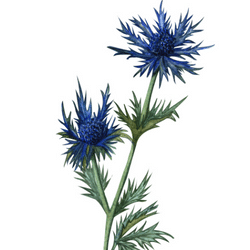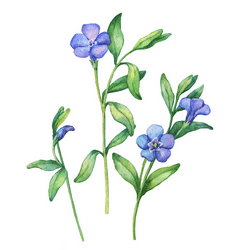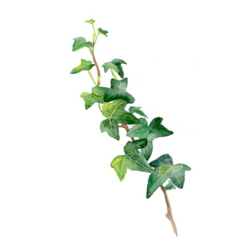William Shakespeare’s Blooms

Shakespeare includes many blooms within his work.
Countless plays feature plants as hidden meanings, messages, and metaphors. The symbology of nature is powerful.
He suggests love, loss, and hatred with the use of flowers, herbs, and trees.
Most of the plants that occur in his plays are easily recognisable to us today. The image of Ophelia from Hamlet handing out her pansies and rosemary, whilst wearing a flower garland, will be familiar to many. As will King Lear’s crown of weeds.
Today, we're celebrating the brilliant bard. So, why not take a look at some of the plants that feature in Shakespeare's beloved plays.
Romeo and Juliet
The first of William Shakespeare's Blooms is the Rose.
What better place to start than with one of the most famous tragedies written in Shakespeare's early career.
A story of two star-crossed lovers. Their deaths harmonise and integrate their feuding families.

"What's in a name? That which we call a rose by any other name would smell as sweet."
Macbeth
William Shakespeare's Blooms include the Yew Tree, and it's flowering berries.
A twisted bloodbath of a brave Scottish general named Macbeth longing to become King! It is said that Yew is one of the cruel, poisonous ingredients that is conjured together by the callous witches in Macbeth.
The Yew or Taxus Baccata is an ancient tree species. It's unique way of growing new trunks and its longevity is associated with renewal, regeneration, and immortality.
It supposedly raises people from the dead!

"Liver of blaspheming Jew, Gall of goat, and slips of yew, Slivered in the moon's eclipse, Nose of Turk, and Tartar's lips, Finger of birth-strangled babe, Ditch-delivered by a drab, Make the gruel thick and slab."
A Midsummer Night's Dream
Next on our list of William Shakespeare's blooms is the Primrose.
A magical, chaotic love triangle forms the basis of this light-hearted play. primroses, cowslips, and oxlips feature here. They symbolise new life, beauty, and early death.
Often Shakespeare uses primroses to suggest disorder and anarchy. For most of us, however, these members of the Primula family are just a bright and cheerful addition to the garden.

And In the wood, where often you and I upon faint primrose-beds were wont to lie.”
"I know a bank where the wild thyme blows, Where oxlips and the nodding violet grows, Quite over-canopied with luscious woodbine, With sweet musk-roses and with eglantine: There sleeps Titania sometime of the night, Lull'd in these flowers with dances and delight."
Much Ado About Nothing
In this play, a joyous celebration is overturned and spoilt by a devious trick.
It is the determined thistle which makes an appearance in Much Ado About Nothing. The thistle represents bravery and strength. It demands respect due to the nature of being covered in nasty prickles.
It is a symbol for overcoming the most feared enemy.

"There thou prick’st her with a thistle."
Hamlet
Another of Shakespeare's Blooms is the Violet.
Hamlet is a tragedy set in ancient Denmark with the titular protagonist, the son of King Hamlet and Queen Gertrude. It is a tale of deceit and honesty. Rosemary, violet, fennel, willow, daisy, and nettles all feature in Hamlet. Many of which make up the garland draped around Ophelia.
The violet represents faith, as alluded to in Shakespeare’s Hamlet.

"There's rosemary, that's for remembrance; pray, love, remember: and there is pansies. that's for thoughts."
The Tempest
This story takes place on a mysterious island. It is virtually in the middle of nowhere. It has magical and spiritual inhabitants. A ship wreck soon changes everything. It brings joy, celebrations and a wedding to all in the final chapter.
Ivy, being evergreen, symbolises eternity and strong affectionate attachment. Much like a wedded couple. Ivy is also a strong and hardy climber that can grow in many different environments. This makes the analogy even deeper.

"...The ivy which had hid my princely trunk, And sucked my verdure out on ’t. Thou attend’st not."
King Lear
The plot unveils in ancient Britain. Elderly King Lear decides to give up his power and divide his realm amongst his three daughters. Who each claim to love their father the most. A tale of war, controversy, corruption, love, and deceit.
Hemlock is lethal. It is extremely poisonous. Eating it almost certainly means death. Therefore, it was formally used as a method of execution.
Nettles are a symbol of protection. They also symbolise exorcism and lust. They are prickly and sting you when touched, yet, they are actually a great food source.
The cuckoo-flower is a delicate shade of pale lilac.

It comes into bloom when the cuckoo starts to call. Hence it's name.
In some areas it is also known as 'lady's smock'. This is perhaps a symbol for King Lear's daughters.
"He was met even now as mad as the vex'd sea; singing aloud; Crown'd with rank fumiter and furrow-weeds. With bur-docks, hemlock, nettles, cuckoo-flowers, Darnel, and all the idle weeds that grow in our sustaining corn."
Othello
A tragedy written around 1603. Othello is based on the story 'A Moorish captain.' It revolves around 4 main characters. Othello, who is a general in the army. Othello's beloved wife, Desdemona. His loyal lieutenant, and the extremely trusted but unfaithful friend. A story of love, betrayal, and jealousy.
The dreadful night when Othello's wife is preparing for bed, little does she know there's a plot to have her murdered. It is here that she sings the sad song of the willow.
Willow symbolises inner wisdom and an open mind. It also symbolises the stability and strength of age and experience.

The bark of a willow tree has been considered important in medicine for a long time. It is in fact where we get aspirin from.
"The poor soul sat singing by a sycamore tree. Sing all a green willow: Her hand on her bosom, her head on her knee, sing willow, willow, willow: The fresh streams ran by her, and murmur'd her moans; sing willow, willow, willow..."

